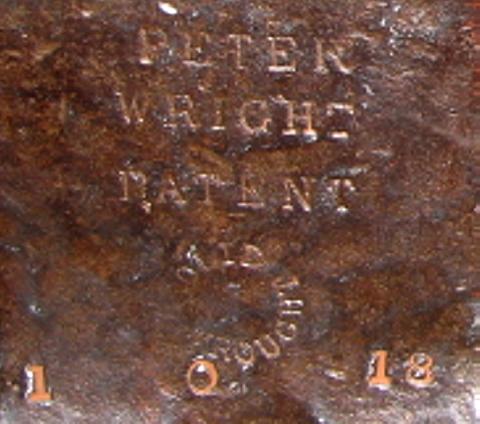Photo provided by Scott Smith.
This is a perfect example of a Peter Wright anvil.
It is in very good condition with minor edge chipping, a little sway, the original finish and no signs of repair.
The weight is in the very common portable anvil range used by farriers, farmers and in small shops.
The "portability" range where a man can easily move an anvil is 100 to 140 pounds, thus the most common weight anvil.
While bigger is better it is also nice to be able to move your tools when needed.
Scott asked me about machining the sway (1/16" on one side and 1/32" on the other (1.6 and 0.8 mm).
I told him to leave it alone! An anvil is NOT a precision reference surface. It is a tool you hammer heavily upon.
It is not a granite flat or a milling machine table. It is an ANVIL!
If you have to put a straight edge on the anvil to see the sway, there is none.
While Peter Wrights are one of the better made more popular anvils of their time they also become swayed more than other anvils.
the reason for this was in their advertisements. They used only new high grade wrought iron for the body of their anvils.
The rest of the industry used scrap or "best selected scrap".
This scrap would often have steel and cast iron bits in it as well as not being so laminar as is good new wrought iron.
Scrap actually made a better anvil body.
Peter Wright addressed the sway problem in later years by crowning their anvils and sloping the horn upward.
The crown was often 1/16" or more high in the center and was definitely NOT a flat surface.
It was compensation for what was inevitably going to happen.

PETER WRIGHT, PATENT, Solid Wrought, 1 0 18
The markings on this anvil are clear and crisp. Scott caught them very well in the photograph.
The serifs on the hand cut letter dies are very clear.
This is something overlooked by crooks making forgeries of Peter Wright tools (buyer beware).
The weight markings "1 0 18" are in
English Hundredweights.
This is a system using 112 pounds as the primary unit, then quarter hundredweights (28 pounds or two stone), and common pounds for parts of a hundred weight below 1/4.
In this case 112 + 0 + 18 = 130




 Return to Misc and Donated Anvils Index
Return to Misc and Donated Anvils Index Anvil Collections Gallery Index
Anvil Collections Gallery Index